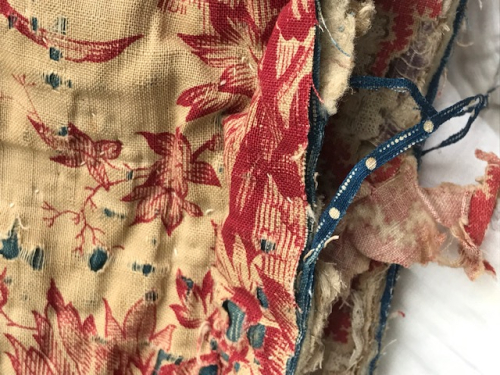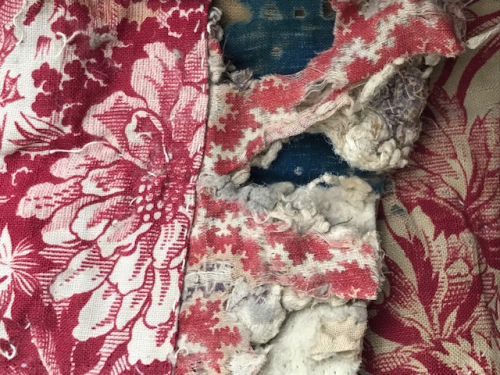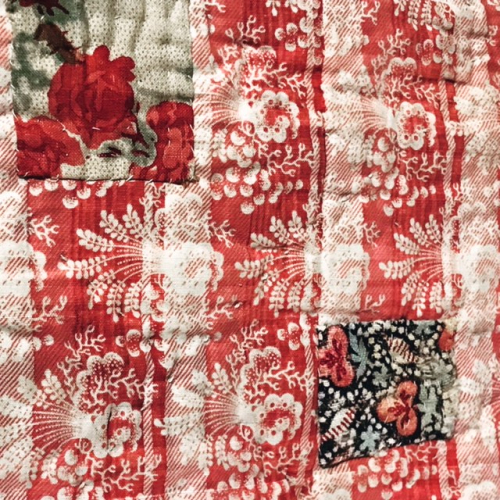If I took every quilt I have ever seen from the French brocantes and laid them out
they would cover France from head to toe. Can you imagine how beautiful that would look
from up above? The women and maybe a few men who over the hundreds of years have created
a national treasure with their handiwork, stitches, their creative force, choice of color and pattern.
Needless to say, if I laid out the monogrammed laced sheets, pillowcases and why not throw in the dishtowels
the entire planet would be covered. You might think I am exaggerating but I am not if I had said universe that would be
stretching the truth but not by much.
On any given weekend you can find quilts at any brocante in France.
A ton of them.
The hardest part is which one to buy and which one to pass up.
The selection is vast if you are not looking for a king size quilt that is.
The most common color is red and blue.
One of my greatest pleasures at the brocantes is talking to the dealers about their wares it is like walking back in time to living history. Each item leads to another chapter of the story that weaves France together. Quilts, fabric, pattern, stitch, needle, pin, thimble, bed, sheet, who slept there, their home country, city, rich-poor… it is all there by the quality of the piece.
The older pieces are hand dyed or stamped.
Sometimes under a 1950s quilt, you can find an older quilt from the 1900s, and more often than not there is an older quilt underneath that.
When a quilt was worn, or thread barren, or even outdated, the quilter would cover the quilt with a newer piece of fabric or patch it.
I remember early on at the brocantes, maybe fifteen years ago or so, I saw my friend Odile carrying a thick 1960s quilt which wasn't her taste at all. I asked her if she had forgotten her glasses. She laughed then pointed to a tear in the fabric, underneath it I saw layers of fabric. Odile said, "You have to look beyond the cover, history is covered with time."
In quilting circles, one was measured by how many even stitches they could do per inch.
I have counted up to twenty-one. The tedious detailing makes a difference for endurance and beauty.
- Average – 6 stitches per inch
- Accomplished – 8 stitches per inch
- Expert – 10 stitches per inch
- Professional – 12 -14 stitches per inch
Remember that 8 to 10 very even stitches per inch is considered superior to 12 to 14 uneven stitches per inch.
These are two pieces that Odlie recently uncovered.
If you would like to read more follow the link below:
"…There are two kinds of antique quilts from Provence and neither is like American antique quilts, which are pieced together from scraps. The Provence quilts tend to be made of two large pieces of whole cloth, either cotton or silk, that are sewn together with some kind of filling element, like batting or cording, sandwiched between them.
''These quilts are intensely quilted and the quilting shows up because the background is often a neutral or solid color,'' said Laura Fisher. Ms. Fisher specializes in American quilts, "There was a strong needlework tradition in Provence,'' Ms. Fisher said. ''It's like a three-dimensional sculpture in thread. Quilting goes back to prehistory. In medieval times quilted cloth was used as insulation in winter garments as well as armor, to protect its wearer from arrows."
"In the 18th and 19th centuries, Provencal women hand-stitched their quilted bed covers with motifs inspired by the bounty of the region: sunflowers, pomegranates, lavender, artichokes, and olives in patterns that completely fill the ground of the quilt.
''The French started printing imported cotton in about 1640,'' Ms. Berensen said. ''By 1680's, the Marseilles women were producing 40,000 to 50,000 quilts a year for export to Germany, England, Italy, and Spain.''
She said that the Marseilles community was so proud of the women's workmanship that it gave the quilts as gifts to royalty and as tokens of appreciation. The French called these quilts ''confections'' or ''broderies de Marseille'' and refer to the stitching as ''embroidery from within.''
They should not be confused with pieces woven on machine-driven looms to obtain a textured character.
The more common bouti is a quilt made from gaily colored printed cottons that are stitched in tight rows or diamond patterns. In the early 17th century, the cottons were imported from India and nicknamed ''Indiennes.'' They were hand-printed with colorful flowers, mythic animals, exotic locales and scenes.
Louis XIV did not want the French to import luxury goods and drain the country's coffers, so he banned the importation of Indiennes. But he instructed his minister Jean-Baptiste Colbert to import the best artisans and dyers to establish textile businesses in France.
''They produced French tapestries, laces, cottons, wools, and upholstery,'' said Ms. Berenson, who is writing a book on Colbert. ''Cardinal Mazarin is known to have had dozens of French quilted bed covers.'' Via The New York Times, Fine Quilts of Provence 2000.
Naturally dyed 1700s fabric.
"Natural dyes are dyes or colorants derived from plants, invertebrates, or minerals. The majority of natural dyes are vegetable dyes from plant sources—roots, berries, bark, leaves, and wood—and other biological sources such as fungi and lichens."
For more information how to make and use natural dyes follow this link by clicking on it.
In the above piece you can see the layers of textiles underneath.
Hand stamped and dyed piece, one of the oldest pieces in this selection of photos.




Leave a Reply